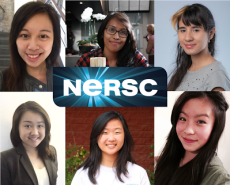NERSC Fields Its First Student Cluster Competition Team
June 6, 2016

Top row, left to right: Davina Ngai, Kristi Arroyo and Grace Rodriguez Gomez. Bottom row, left to right: Yong Li Dich, Ruoyun Zheng and Elizabeth Wang.
Five former NERSC interns and one current intern have joined forces to participate in the Student Cluster Competition at ISC16, June 20-22 in Frankfurt, Germany, marking the first time that NERSC has fielded a student cluster competition team.
The all-female team comprises two high schoolers and four college undergrads:
- Kristi Arroyo, a sophomore in computer science at the Missouri University of Science and Technology
- Yong Li Dich, a freshman at Harvard University who plans to pursue computer science
- Davina Ngai, a second year civil engineering student at Queen’s University, Canada
- Grace M. Rodríguez Gomez, a computer science student at the University of Puerto Rico
- Elizabeth Wang, a junior at Monta Vista High School in Cupertino, Calif., who loves coding
- Ruoyun Zheng, a junior at Monta Vista High School who enjoys programming and playing basketball
The team is being guided by Rebecca Hartman-Baker, acting group lead for NERSC’s User Engagement Group. This is not her first time organizing a student cluster competition; when she was with iVEC in Australia she coached teams for the Student Cluster Competition at SC13 and SC14.
Since being assembled last fall, the team—which is scattered all over the U.S. and internationally this summer—has been meeting weekly via Zoom to come up to speed on the competition and cluster requirements. Fortunately they all knew each other previously, which helped facilitate the collaboration process, Hartman-Baker said.
“All of them except one were interns at NERSC last year,” she said. “They know each other better than they know me or I know them. They are an awesome group of young ladies to work with.”
Their camaraderie should serve them well during the three-day competition, where 12 teams will race against one another to demonstrate the best performance across a series of benchmarks and applications on a small supercomputer cluster that they designed and built. Each day the teams will run problem sets given to them by the competition, such as WRF, a well-known weather modeling application; SPLOTCh, a visualization program for astronomy; and Graph500.
Each team member was assigned a specific role and an application to specialize in, Hartman-Baker noted. For example, Wang and Zheng are practicing to be the “mystery application” experts, compiling a number of codes to gain experience running whatever unknown codes the competition might throw at them. And the Graph500 experts had to write their own implementation of the benchmark’s breadth-first search algorithm. They chose to write it in UPC (a Berkeley Lab product) and sought advice from local experts in optimizing their code.
“Everyone on the team knows a little bit about every part of the process, but each ‘expert’ has more in-depth knowledge about her chosen application,” she said. “The team will run the competition codes on their cluster during the competition and answer questions from judges testing their expertise.”
Hartman-Baker and the team worked closely with Intel and Cray to select and procure the parts they used to build their cluster. The vendors are also team sponsors, providing travel funding in addition to the hardware. The cluster arrived at NERSC in early May, and Hartman-Baker and Steve Leak, an HPC consultant at NERSC, have been hard at work getting it up and running so the team could access it remotely and practice running their applications on it.
Rodríguez Gomez, who is interested in working in computer graphics after she graduates next year, is excited but also a bit nervous about participating in her first Student Cluster Competition.
“This is a very good opportunity because it will be the first time for me competing in something like this, although I am a little concerned about setting up the cluster because I don’t have much experience with that” she said. “I did have some experience working with supercomputers at Berkeley Lab, so I thought this would be a good way to extend those skills and a great opportunity for me to learn more about computers and applications.”
While an all-female Student Cluster Competition team is rare, it is not unprecedented, according to Hartman-Baker; for example, at SC12 and SC13 there was an all-female team from the University of Pacific that was sponsored by Lawrence Livermore National Laboratory.
“It is so fun working with young people, to see how much they learn and how smart they are,” she said. “I learn a lot too, every time."
For more on NERSC’s first Student Cluster Team, visit their web page.
About NERSC and Berkeley Lab
The National Energy Research Scientific Computing Center (NERSC) is a U.S. Department of Energy Office of Science User Facility that serves as the primary high performance computing center for scientific research sponsored by the Office of Science. Located at Lawrence Berkeley National Laboratory, NERSC serves almost 10,000 scientists at national laboratories and universities researching a wide range of problems in climate, fusion energy, materials science, physics, chemistry, computational biology, and other disciplines. Berkeley Lab is a DOE national laboratory located in Berkeley, California. It conducts unclassified scientific research and is managed by the University of California for the U.S. Department of Energy. »Learn more about computing sciences at Berkeley Lab.







